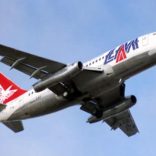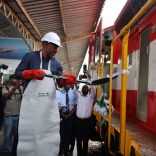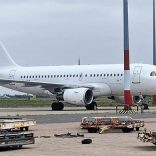Mozambique: Government lifts time restrictions on commerce
Eastern promise

Maputo Port (Courtesy photo)
The imports of porcelain from China, quartz from Arabia and carnalians from India, along with exports of gold and ivory from Great Zimbabwe was the dominant cargo that dotted the shores of Kilwa Kisiwani, the most powerful port on the East African coast, an island off the coast of Tanzania. But that was some 600 years ago, when Kilwa was undoubtedly the richest gateway port between Africa and Asia.
Today, the ports that dot the eastern coast remain valuable as facilitators of trade with Asia. Numerous reports from credible organisations like the International Monetary Fund, the African Development Bank and Young & Ernst, also attest to the region being the fastest growing in Africa, with Kenya and Tanzania touted to be top performers, based on performances recorded last year.
Those two nations, along with Mozambique, have as an advantage, strong maritime institutions and policy frameworks that foster trade and are considered by the Port Management Association of Eastern & Southern Africa (PMAESA), to be catalyst in terms of regional growth.
PMAESA’s secretary general, Nozipho Mdawe explains that those particular maritime gateways are crucial transit points for goods travelling into Africa’s hinterland areas, spider-webbing into East and Southern Africa, Ethiopia, South Sudan, Uganda, the Democratic Republic of Congo, Rwanda, Burundi and Malawi. “The three nations appreciate the critical role of hinterland transport linkages that are imperative to the competitiveness and trade capacities of ports and have thus taken measures to facilitate ongoing and improved capabilities.
“Kenya and Tanzania, for instance, have made huge capital investments in road and rail linkages and there is an appreciation of the role of the soft infrastructure required to increase efficiencies, reduce transit times and costs. This is evidenced by the introduction of One Stop Border posts such as the Kenya-Uganda border; Electronic Cargo Tracking System between Kenya, Uganda, Tanzania and Rwanda; Single Window Systems such as that of the Kenya Trade Net System; and Corridor Management Institutions – NCTTA, CCTTFA and North South Corridor.”
While such measures are laudable, they are in themselves not enough to address the challenges on and off coast. “Port capacity and port logistics have not kept up with increasing import traffic passing through East African Ports,” says Mr Mdawe. “This has caused severe congestion, directly attributable to deficient physical infrastructure, malfunctioning regulatory systems, and poor management.
“The result is that our ports are not as efficient as they could be and serve only to raise Africa’s trading costs, such as was the experience of the Port of Mombasa, Kenya, which was further challenged during the five years between 2005 and 2010 with piracy risks that have largely subsided. The port was also frustrated by substandard and unreliable rail services, poor road infrastructure and missing links, particularly those into the hinterland.”
Beyond limits
The Port of Dar es Salaam in Tanzania has also experienced difficulties having no Inland Container Depots for temporary storage nor Container Freight Stations for the consolidation of goods into containers.
What exists currently is a high trade imbalance. African ports are recording the highest rate of empty containers being shipped out. According to PMAESA, Kenya and Tanzania ship 42%-53% full boxes, and this is a reflection of three main factors that generally characterise the African shipping industry: high volumes of unprocessed exports, which do not require containerisation; low volume of manufactured exports; and a heavy dependence on manufactured imports.
Without increased exports and improved port efficiency, exporters in the region will be marginalised; served by feeder services. “Shippers will have to bear higher maritime transport tariffs and without improved port efficiency, several coastal countries in the eastern and southern areas could become de facto landlocked, having to bear similar approximately costs as a landlocked country,” says Mr Mdawe.
Such issues highlight the reason why African ports in general, have to work beyond their capacity limits. Mr Mdawe says such shortfalls are reported across all sub-Saharan maritime trading areas. “This is partly due to the demand for resources such as oil, which have also led to growing economic activity in the hinterland of East Africa, and this has scaled up the demands being placed on the ports, particularly those of Mombasa and Dar es Salaam.”
While East African governments look to address their nation’s infrastructure problems, they will also be looking to increase human resource capacity and introduce policies to foster private sector investment in ports. But as Mr Mdawe reminds us, given that the regional ports will be starting from a low base in terms of capacity, “the industry has substantial economic and investment prospects going forward”.
Future proofing
The future indicates that seaborne imports are expected to grow from 128m tonnes in 2014, to 485m tonnes by 2045 in sub-Saharan Africa, so it is imperative for terminal operators to be adequately prepared for increasing import traffic. They can do this by optimising the use of cargo handling equipment and the introduction of communication systems for co-ordinating supply chain information.
With vessel owners constructing larger vessels, the nature of container port demand means that shipping carriers are imposing higher container throughout peaks on related stakeholders and industry players. This combined with the weight of worldwide growing demand, means that the region’s terminal and hinterland infrastructure are now under severe pressure.
“At the moment, the trend towards bigger vessels is unstoppable because costs are significantly reduced and offers substantial competitive advantages for the carrier,” says Mr Mdawe. “Our ports will have to expand in order to welcome these bigger vessels and obviously increase their container handling capacity.”
Not just that, road and rail infrastructure will have to develop at the same pace. “It’s the only way to support upcoming growth. With seaports increasing the quantity of goods traded and reinvestment into capacity, inefficient linkages will backfire on overall port efficiency and increase turnover time and costs per container.”
In the meantime, ports are having to adapt and have begun to operate with more flexibility particularly during peak periods. They do this by embracing a value chain approach, as opposed to the silo mentality, which Mr Mdawe says has traditionally plagued the region. But with the development of transhipment hubs, the region is set to experience the expected growth as countries invest in the development of new ports and terminals with capacities to handle larger vessels but again, as Mr Mdawe emphasises, it is the three crucial factors of location, infrastructure and operations, that will influence decision-makers.
Facilitating business
From a cargo carrier’s perspective, there is a need for them to support and help with the development of long-term strategies that will foster sustained relationships. The advice from PMAESA is that they will need to collaborate with local partners in order to access political and business relationships, such as the one that DP World has with a number of African ports. “The benefits may not seem apparent in the beginning,” Mr Mdawe warns, “but by maintaining a broad portfolio of projects in the region, and understanding that approaches vary from country to country, there is no doubt that growth can be mutually beneficial.”
DP World Maputo’s chief executive Tejas Nataraj agrees: “In an African context there is tremendous value in simplifying procedures and enhancing the ease of doing business. A number of opportunities exist such as Integrated Logistics Services – linking vendors such as ports, warehouses, transporters, documentation agents etc – to ensure the streamlining of the movement of goods from shop floor to final market.
“Electronic data will eliminate the need for paper transactions and move us from data to digital. Electronic Payment Gateways will improve financial transparency as well as the ease of transactions. More importantly with the development of world-class infrastructure and efficiencies, economies of scale will drive down costs making products and services more accessible to the population at large.
“Whether it be in infrastructure, equipment, technology, connectivity or the workforce, my experience at DP World Mundra (India), has taught me that being invested to stay ahead of the game requires a visionary mind-set. Structurally there is so much that is well placed for the continent right now – increasing urbanisation and a growing middle-class for example, plus the oil and gas finds – translates into doing business in Africa needs to be with perseverance and teamwork to build strong, versatile and robust businesses. These opportunities mean that Mozambique, and the Port of Maputo will take its rightful place on the global stage – it is a diamond that is in the process of being polished,” concludes Mr Nataraj.
REGIONAL HUBS OF HOPE
Bosasso Port, Somalia: Despite the news that P&O will be developing Bosasso port, cards are being held close to the chest of those who have knowledge of the intended upgrades. Some commentators believe it is premature to speculate how significant the development of Bosasso will be on the region, while others caution that unless linkages to markets are developed simultaneously, the ability of the port to efficiently transfer goods and cargo inland will be constrained.
Port of Mombasa, Kenya: Over the past decade, Kenyan Ports Authority (KPA) has undertaken development programmes that have seen the Port of Mombasa move from being a small harbour facility to a modern international operation. Key projects currently underway include a Second Container Terminal, facilitation of the development of neighbouring Free Trade Zones, security upgrades and dredging of the channel to accommodate larger ships. Catherine Mturi-Wairi, managing director of the KPA, says that the upgrades have seen the port experience continued growth in container traffic and overall throughput. “Over the past three years, the port has consistently handled over 1m teu thus enabling Mombasa to feature in the global map of top container ports. Last year, the port handled 1.1m teu and the overall throughput grew by 2.4% to post a best-ever performance of 27.36m tons, against a backdrop of slower than expected global and regional economic growth.”
Dar es Salaam Port, Tanzania: The Tanzania Ports Authority (TPA) reports that improved efficiencies at the port have resulted in an additional 120 000 tons of imports and exports to an annual freight tonnage of 16m. The director general of TPA, Deusdedit Kakoko comments that the upward trend of increased cargo volumes has continued into 2017. The port is scheduled for modernisation and expansion as a flagship project for 2017/2018 with the Ministry of Works, Transport and Communication providing some TZS187bn ($83m) for the upgrades.
STRATEGIES FOR SUCCESS
DP World Maputo’s chief executive Tejas Nataraj outlines the organisation’s strategies that couple development with a strong commercial drive that will, he assures, attract not just additional volumes from inner Africa but encourage new services at the Port of Maputo.
“I believe that DP World Maputo is building a strong foundation in translating the vision of being a sustainable enabler of global trade. Mozambique has an extensive coastline and ports like Maputo are geographically well placed to service South African and landlocked countries such as Swaziland, Zimbabwe and Malawi. Additionally, it has the opportunity to be great regional hub for shipping lines. With the dredging project for the Port of Maputo slated for completion, larger vessels will be able to use it as a hub for larger vessels.
“We are also putting in place the capabilities to address civil infrastructure, equipment and processes to ensure that we live up to the full potential that the port can offer,” he says.
The first phase of development, augmenting both capacity and capability, is well underway and will be completed by 2018. These works will increase the terminal capacity to 400,000 teu annually. This phase includes the refurbishment of 15 hectares of yard area, taking the total container stacking area to 20 hectares; the refurbishment of a 400-metre wharf to enable berthing of 14.3 metre draft vessels; and the deployment of super post panamax cranes giving the terminal the capability to handle the largest vessels that call at Africa’s ports.
“A portion of newly-developed pavements has been completed along with the delivery of six new rubber-tyred gantry cranes,” says Mr Nataraj. These upgrades to equipment and yard are game-changers in terms of the efficiency with which we handle our operations.”
In the second phase, to be completed by 2021, a new berth of 350 metres will be added taking the total handling capacity to nearly a 1m teu per annum.













Leave a Reply
Be the First to Comment!
You must be logged in to post a comment.
You must be logged in to post a comment.